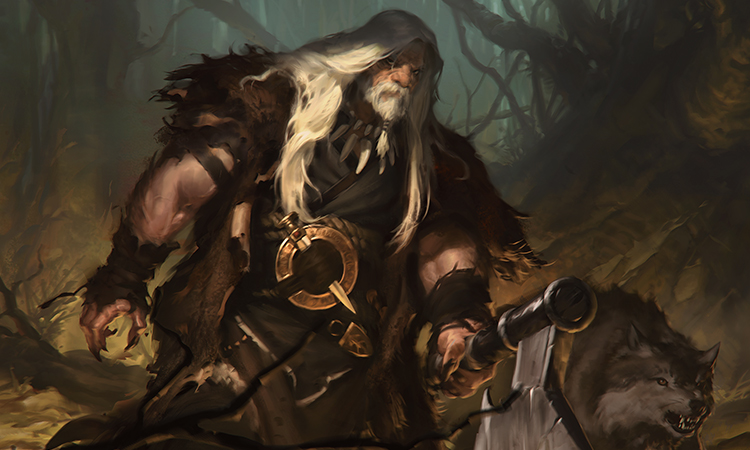Eldritch Perfect, Part 2
Last week I started with my card-by-card stories of Eldritch Moon. I had too many stories to tell for a single column, so I'm continuing my storytelling today. That said, let's get to it.
Liliana, the Last Hope
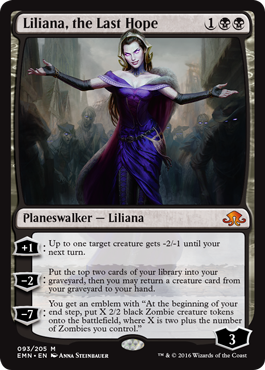
There's a lot going on in Eldritch Moon. One of the most important things is Liliana finally getting a chance to play the hero. Emrakul is doing horrible stuff to the denizens of Innistrad, with one big exception—it's hard to warp your mind when you don't really have one. Yes, of all the creatures on Innistrad, it's the Zombies that have proven immune to Emrakul's effects. That means the ability to control Zombies is extra valuable. And wouldn't you know it, guess who's on Innistrad? Our favorite necromancer, Liliana.
The key to designing Liliana was making a card that played up her necromantic powers. We started with her ultimate. When you look back at the history of Magic, what card best captures the power of a Zombie army? My choice is this card:
Endless Ranks of the Dead was a top-down design made to represent how the Zombie hordes just keep growing. What if Liliana's ultimate was Endless Ranks of the Dead but more powerful? Instead of increasing by half the number of Zombies you have, how about doubling the Zombies you have plus two (you know, just to help you get started out if you somehow don't have Zombies)?
Her first ability was made to protect her, while the second helps her start up a Zombie army, so that she'll be ready when her ultimate kicks in. The card also pushes you toward a more controlling Zombie deck, as the key is for you to last long enough for Liliana to start pouring out hordes of Zombies.
Oath of Liliana
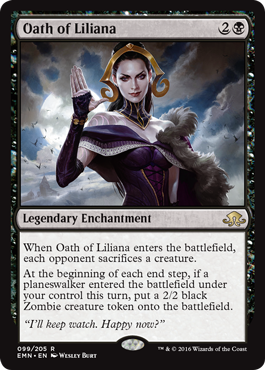
As I explained in the Oath of the Gatewatch version of this article, the Oaths exist as a mechanical means to show when someone new joins the Gatewatch. Oaths have a simple structure. They feature an enters-the-battlefield ability and then a static ability that rewards you for having planeswalkers. Oath of Liliana's enters-the-battlefield effect does one of the things she's best at, killing things, and its static ability does the other: making Zombies.
Peace of Mind—reprint
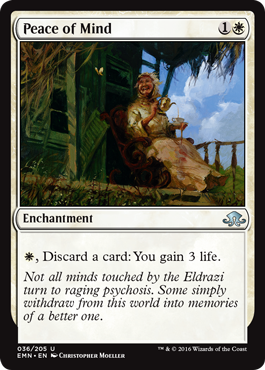
One of the fun parts of designing a set is trying to find reprints. But not just any reprints. The coolest reprints are ones where we haven't reprinted them many times. It's great to find a card from back in the day that is a perfect fit for your set's mechanical identity. We are allowed to change names and card concepts when we reprint a card, but the best successes are the ones where the card name not only doesn't need to change but works as-is in the new environment.
Peace of Mind is the perfect example of what I'm talking about. The card has only appeared twice: in Exodus where it premiered and then in Ninth Edition. It was just a quirky life-gain card before, but in Eldritch Moon it's a white madness and delirium enabler that also allows you to get graveyard-relevant cards into your graveyard, all while having a perfect flavor. You want to stay sane in Innistrad? Well, doing so will mean being willing to give up pieces of your mind. (The pun in the title is just the cherry atop the hot fudge sundae that is this card.)
Stensia Innkeeper
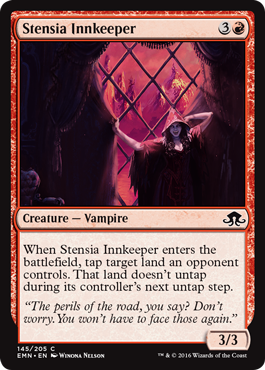
This card probably reads weird at first blush. What's going on here? Blue's normally the color that prevents things from untapping. To understand this card, let's pull back the scope a bit. Since the beginning of the game, red has had the ability to destroy lands. Over the years, though, we've dialed back the power of land destruction because the game isn't fun if players simply can't play.
The question R&D has been asking itself is whether there's a way to let red have some access to land disruption without necessarily destroying the land. Is there some effect that's effective but less so than "destroy target land"? "Tap target land and it doesn't untap" is our current stab at this problem. This allows red to disrupt mana, but only for a single turn.
Will this become something red does more of? Maybe. We're testing it out to see if it does what we want it to and whether or not we have the right power level for it. That's what Stensia Innkeeper is up to and why it has that line of text.
Tamiyo, Field Researcher
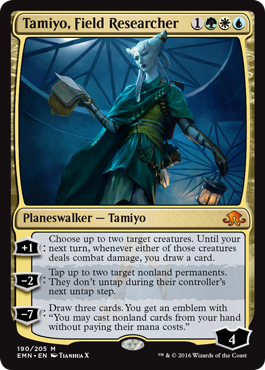
In Avacyn Restored, we introduced the audience to a moonfolk scientist Planeswalker from Kamigawa who studied moons. She had used her ability to walk between planes to find many different worlds and learn all she could about moons. Innistrad, in particular, had a very odd moon made of silver. When we returned to Innistrad, one of the questions raised was about the fate of Tamiyo. Was she still on Innistrad, or had she ventured off to another world to study its moon? The audience has come to embrace Tamiyo, so the creative team decided to use her in the story. Her research into Innistrad's moon fit perfectly into the way they wanted to craft the story.
But we had a small problem. Four of the five planeswalker slots were accounted for, and the fifth had special color needs that Tamiyo didn't fit (more on this below). It just seemed wrong that she didn't get a planeswalker card. The Gatewatch is around so that if we don't get a planeswalker card in one world, we can catch it in the next. Tamiyo, though, was only here for the current story. If we missed giving her a planeswalker card here, it could be years and years before we got another chance.
The creative team went to Erik Lauer (the head developer and the person who cares most about planeswalker balance) and pleaded their case. Erik explained that the reason he limits planeswalkers to five per block is so that Standard has the proper amount of planeswalkers in it. But maybe there was a way to do this. The narrower a planeswalker, the less troubling it is for Standard. Could we find a way to make Tamiyo a three-color planeswalker? That would push her toward a very specific deck, meaning that development could better monitor her and make sure her impact was controlled.
Three-color Tamiyo was better than no Tamiyo, so the creative team went to work. Okay, obviously she needed to be blue. She was also a scientist, which tended to push her more toward Simic (blue-green). Also, her role in the story was her trying to figure out what was wrong with the world in order to save it. It could be argued she had some white in her. Okay, for this set Tamiyo is Bant (green-white-blue).
The trick to designing a three-color planeswalker is making sure her abilities feel as if they hit all three colors. Also, although Tamiyo was now green and white, her core color was still blue—so that needed to come through the strongest. Her first ability grants what we in R&D call "curiosity" (combat damage leading to card drawing). Curiosity is in blue and green. The second ability is what we call the "frost" ability. It's tapping a creature, which then doesn't untap next turn. That ability is done primarily in blue but also a little in white (although white normally just does the tapping part; interestingly, in Kamigawa—where Tamiyo is from—this ability was also in green on the Snakes). The last ability is primary to blue but is something that green and white occasionally dabble in with specific types of cards. Overall, this Tamiyo is more blue than green or white (as is the character), but you can see traces of the other colors in the abilities.
Thalia, Heretic Cathar
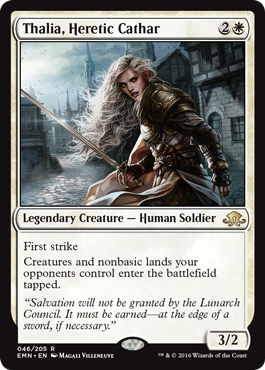
Thalia was another legendary creature that we had to match the design to. We first met Thalia (card-wise) in Dark Ascension.
She was a good soldier who helped protect her team from outside influence, reflected in her messing with noncreature spells. The new Thalia is still a soldier and still protecting, but she's a little tougher. Now, instead of a 2/1 first striker, she's a 3/2 first striker. The new Thalia still messes with your opponent with her static ability, but now, rather than stopping noncreature spells, she's messing with your opponent's creatures (and nonbasic lands).
Thalia's ability is inspired by a card from way back in the day: Kismet from Legends.
This effect slows down the opponent, allowing you to be more aggressive.
Tree of Perdition
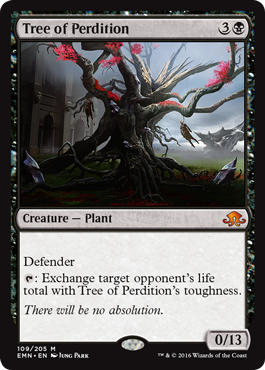
One of the fun things about revisiting a world is that you get to make new cards that call back to cards from the original visit. Tree of Perdition is one such card. The card it recalls is this one, Tree of Redemption:
Tree of Redemption wasn't actually made in Innistrad design, but rather added during development. Erik Lauer, the set's lead developer, was looking for a new mythic rare and came up with this card. He was trying to make something creepy and flavorful but really different. The card had 13 toughness to play into the block's theme of the number thirteen.
The card was very popular, so in Eldritch Moon we decided to revisit it with a small twist. Rather than swapping your life total for its toughness, what if you could do so with your opponent's life total instead? The card was identical except for that one swap. It was still a 0/13 for four mana, one of which was colored, and it had defender. Green, though, isn't the color to lower your opponent's life total in such a manner. Checking the color pie made the choice clear. Red can do direct damage to the opponent, but the king of life-lowering was black. So the Tree of Redemption became the Tree of Perdition.
Ulrich of the Krallenhorde / Ulrich, Uncontested Alpha
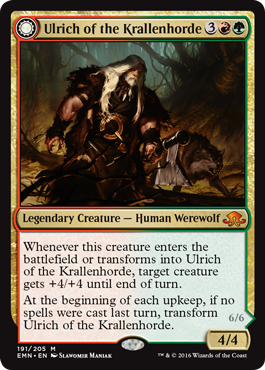
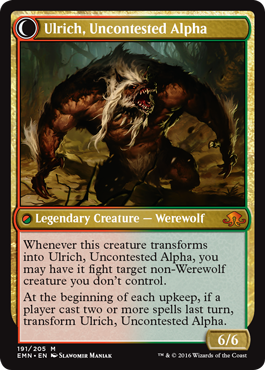
There comes a point with every set when your work is done and nothing more can be changed. You then wait for the product to come out and see the audience's reaction. Most of the time, the audience is excited by what you included, but with every set there's something the audience anticipated that you didn't deliver. With Innistrad block, that thing was a legendary Werewolf.
We had toyed with making a legendary Werewolf, but we had concerns and ultimately decided not to make one. Well, as decisions go, that one went over poorly. You see, Commander has become a very popular casual format, and players really like to have legendary creatures in each set that embody new themes. Innistrad was, for all intents and purposes, introducing Werewolf tribal to Magic. Commander players wanted to make Werewolf decks, but while there were plenty of red-green commanders to choose from, there wasn't a Werewolf commander.
As is often the case when we "miss" something, the player base was quite loud in communicating their unhappiness, so I was well aware that a legendary Werewolf was something they all wanted. Sometimes these misses can be picked up in other expansions or in supplemental products (as we had done with Gisa and Geralf, the other big miss from Innistrad block), but a double-faced red-green legendary Werewolf is not the kind of thing we can easily drop somewhere else. Really, the only place for us to put it is in a block set on Innistrad. The day I realized that the return to Innistrad was a go, the very first thing I made a mental note of was "red-green legendary Werewolf."
Okay, we were returning to Innistrad and the legendary Werewolf was on my radar. What could possibly go wrong? We designed Ulrich (a proto-version, as the card changed a bit through the process) early in design and put him into the card file with a note in the database stating this was the slot for the legendary Werewolf. That done, we turned our focus to elsewhere in the set.
One of the many things we have to be careful about is having a color balance of planeswalkers in Standard. We try to make planeswalkers all have shots at Constructed play, so to have proper balance it is key that we weight them evenly among colors. This is so important that the creative team has a spreadsheet, complete with calculations, so they can track which set needs which colors.
Shadows over Innistrad block started, as all blocks do, with five planeswalker slots (see Tamiyo above for more on this). Who were the major players in the story? Jace was mono-blue, Liliana was mono-black, Sorin was white-black, and Nahiri was red-white. Assuming multiple colors count as half, here was the breakdown we had:
- White: 1
- Blue: 1
- Black: 1.5
- Red: 0.5
- Green: 0
White, blue, and black were covered, with black being a smidgen high. Red was low and green was very low (aka nonexistent). As the characters we had really couldn't change and their colors were locked in, that meant the fifth planeswalker really needed to be red-green. Also, last time we were on Innistrad, we had a double-faced planeswalker with Garruk. We don't often get to have double-faced planeswalkers (especially where they're planeswalkers on both sides), so if this missing planeswalker could also do that, it would be nice.
All of this led us to the same place we had ended up in original Innistrad with a Werewolf planeswalker. (Before we decided to make Garruk the double-faced planeswalker, it was a red-green Werewolf planeswalker.) Okay, that sounded pretty cool. The creative team had a cool take on who that planeswalker could be, and we ended up with Arlinn Kord.
All that was fine and good, but it now meant that we had two mythic rare red-green double-faced Werewolves. That was a problem. Could we please move the legendary Werewolf to Eldritch Moon? Sure. It didn't really matter which set the legendary Werewolf was in as long as the block had it. Yeah, the audience would be expecting it in Shadows over Innistrad, but surely they could wait a few months more. Okay, we moved it.
Fast-forward to many months later. We're now working on Eldritch Moon. As I explained in my second preview column, we ended up using the double-faced cards to represent the dark mutation of Emrakul. Instead of the sun and crescent moon, we had moved to a full moon and Eldrazi symbol, as these double-faced cards weren't like the ones in Innistrad, Dark Ascension, or Shadows over Innistrad. Well, except one exception.
The legendary Werewolf really needed to act like a normal Werewolf. It didn't want to be a Werewolf on front and an Eldrazi on back like all the other Werewolves in the set. That didn't work on numerous levels. But if Ulrich didn't do that, then it would break the whole pattern of the double-faced cards in Eldritch Moon. So it was suggested that we remove it.
No, no, no, no, no, no, no. If I only had to guarantee one card in the entire block, it would be the red-green legendary Werewolf. Original Innistrad block had been a fan favorite. It hit big on so many different levels. The number of things we had "missed" could be counted on your fingers, and by a huge margin, the number-one error of exclusion had been the lack of a red-green legendary Werewolf. We couldn't miss it again.
I dug my heels in. Other people in R&D dug their heels in. Our job is making the players happy. Yes, we were messing up the pattern of the double-faced cards. Yes, we were fitting a round peg in a somewhat square hole, but I didn't care. There was no way we were not printing a red-green legendary Werewolf. It took some work, but in the end Ulrich stayed and was just a special exception.
Cut to a year or so later. Shadows of Innistrad comes out. There's no red-green legendary Werewolf. The block has two sets. I'm sure the players will wait to see if it's in the second set. Nope. I start getting mail immediately. How could we fail to print a red-green legendary Werewolf? Now, I don't make a habit of telling people what's coming out in future sets, so I have to play it coy. "You guys wanted a red-green legendary Werewolf? Why didn't anyone tell me?"
The mail continues. Discussions happen all over various sites. There are articles written on the topic. There are podcasts recorded on the topic. In every interview I or any of the R&D people do about Shadows over Innistrad, we always get the "Where's the legendary Werewolf?" question and we all have to act coy.
So when I say, "I'm happy Eldritch Moon is finally public," I really, really mean it. Enjoy Ulrich, everyone, and just give me a few days before you come to the conclusion of what we missed this time around.
The Moon Drifts from Sight
And those are all the stories I have to tell. (Well, for today at least.) As always, I'm eager to hear feedback on today's column and Eldritch Moon. Were there any cards you wanted to hear about that you didn't? How's the set playing? What are you enjoying and what would you like to see done differently in the future? Let me know through an email or on any of my social media accounts (Twitter, Tumblr, Google+, and Instagram).
Join me next week, when I answer your questions all about Eldritch Moon.
Until then, may you play a bit to come up with some questions.
"Drive to Work #348—Two-Block Model"
In this podcast, I talk about how the two-block model came to be.
"Drive to Work #349—Twenty Lessons: Piggybacking"
This is the fourth of 20 in my series "Twenty Lessons, Twenty Podcasts" going into depth on each of the lessons from my GDC talk. My three articles on that talk can be found here (Part 1, Part 2, and Part 3).
- Episode 349 Twenty Lessons: Piggybacking (15.4 MB)
- Episode 348 Two-Block Model (15.2 MB)
- Episode 347 Stand-up Comedy (19.3 MB)
- Episode 346 History of Limited (17.5 MB)
- Episode 345 Twenty Lessons: Resonance (15.4 MB)


